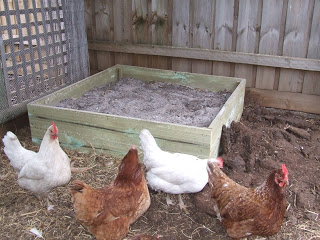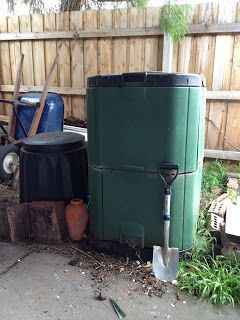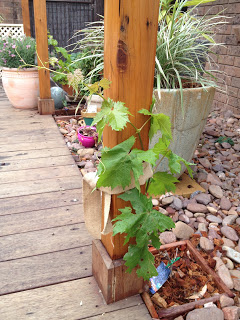Everyone knows that most machinery cannot run very long with out regular maintenance, so why not take the time to maintain our gardens? I find that to keep it fruitful and healthy, regular maintenance chores are a must.
Once a month, when the moon is a waning crescent, I get out into the garden for a spot of maintenance. This maintenance is usually a half a day’s work, but is a relaxing and rewarding part of my gardening routine.
It consists of tasks like observation, inspection, repairs, weed control, fertilizing, pruning, training vines, and composting. Yesterday was my maintenance day, so let me walk you through the tasks that I completed.
Chickens.
No garden would be complete with out chickens so they are the first part of the routine. Upon feeding the chickens, I inspected their run for any attempts at escape or intrusion around the fence. I found nothing, but noted that the ground was beginning to compact, so I dug the hard soil over with my garden fork. If we owned a rooster, he would normally perform this task with his big strong talons, but in the absence of one, and according to the feathered girls, I am a suitable surrogate! They enjoyed looking for worms in the large clods of soil and helped to break them up for me.
I then inspected the hen house roofs as we were expecting strong winds. All good, so I then checked each hen for scaly leg mites, and treated one of them with olive oil.
If they need cleaning, then I keep the litter and distribute it around the garden as mulch or if too fresh, then into a compost bin to rot.
Weed Control.
During the inspection, I noticed cooch grass beginning to invade the garden bed that contained the Apricot and one of the 3 Olives. So it was weeding time around the entire orchard which only took me an hour (it is a large area). It was certainly made a lot easier after all the sheet mulching we finished before Sustainable House Day. A bed that size would have normally taken an hour by itself, now only took me 10 minutes.
For me, weeding is time spent in reflection, with classical music playing in the background, mulling over the events of the previous month, and pondering any problems requiring solutions, and planning for the coming month.
Once completed, the weeds are thrown into the chicken run for demolition!
Composting.
This task is performed on a fortnightly basis, but it was time to rotate the compost, so I used my aerator device and stirred up the material in the normal black compost bins, and sprinkled a half handful of dolomite lime to sweeten it. The large Aerobin was checked for decomposition and I noticed that it was getting a bit putrid. To rectify, I added some brown material (used sugar cane mulch) to absorb the excess moisture and act as an activator for the microbes.
Fertilise.
As I have many fruit trees in large pots, these plants need regular addition of nutrients that they would otherwise have absorbed via the soil. I use a manure and weed tea that I have brewing in two large seal-able buckets. I diluted this stench down with water to a ratio of 1:8 in a 9 litre watering can. It is then applied to each tree, half a can per pot, and I find that this helps maintain plant health.
Tree Maintenance.
I inspected each of the 25 fruit trees for disease or fruit damage. I observed that I should reap a large crop of olives from two of the three trees. I also noticed a small amount of curly leaf fungus on the nectarine and yellow peach trees, and will have to spray them with Bluestone mixture (copper sulphate) before bud burst next year. The curly leaf is not too bad so nothing needs to be done at this stage.
As the stone fruit all throughout the orchard are heavily laden with fruit, I made the decision to knock the all smaller fruit off the branches. This will ensure that the tree focus more upon growth of the remaining fruit making them fat and flavoursome. I also trimmed some branches that were overhanging pathways or looked dead or diseased.
Vines.
The new grape vines are growing strongly, and they needed to be trained up the posts of the arbour I have been utilising thick jute ribbon for this purpose as it allows the vine to expand as it grows. I also pruned off any side shoots to maximise upward growth. I am hoping that they reach the top of the arbour by the end of the growing season in April. I fertilised each vine with nutrient tea to promote healthy growth.
Relax.
After all this work it was nearly time to relax, but not quite yet. Around late spring we like to partake in a cold beer after working in the garden, so to provide a continuous supply I had to brew another batch of Aztec Gold cerveza It will be ready to bottle in a week or two, and only took 30 minutes to complete.
Then it was really time to relax, have a beer or two, and survey the surrounding landscape and feel proud of my handiwork. Relaxation at the end of a long day’s maintenance is an absolute necessity. Otherwise, without this reward, you will probably not continue the maintenance routine month after month.
Not many people understand that gardens are also for pleasure as well as a bountiful harvest, so it really enhances the experience by taking the time to enjoy the simple pleasures of the setting sun over my green oasis.
Summary
Obviously there is more work in the spring/summer and less in the autumn/winter, so each months maintenance will vary with workload. However, with a little forward planning you too will be able to keep your fruit, veggies, and livestock healthy and abundant.
There is nothing as rewarding as a job well done.





Everything you say makes total sense. You must have slept well after all of that. Superb sunset, too!
I really need to get in and do some serious weeding. It has been so dry which makes weeding hard but we have just had some good rain so now is the perfect time.
A great post Gavin. Good advice too. I’m off to the allotment this morning to do a bit more mulching as we prepare for the heat of a Queensland summer.
I love a garden stroll – we usually have a daily inspection at our house. Need to battle the cherry aphids and start netting here.
What a great post and one I have filed away in my mind to work into our own maintenance plan. I did some weeding the other day (learned the hard way not to use straw as mulch as the seeds are all sprouting) and we are definitely due for a fertiliser run. I have 2L of worm wee to share around my veggies and some spuds to bury too. 🙂
Planned maintenance we used to call it – and very redundant I thought it in my young and salad days. I know better now I’ve been a homeowner for a while. I think we’re used to this sort of thing for our lawnmowers and vehicles, but don’t put it into play with the garden or other aspects of home. I really like the way your routine involves inspection in each space – I have a tendency to notice something and make a “mental note” to do something about it when I get a chance – which of course I always forget to do. A planned inspection would allow me to actually write it down. What an aha moment. Thank you! And to think I used to work in an environment that did just that – if only I’d made a mental note 🙂
Nice routine you have going, id like to know how you compost the chicken litter though ? ive got raised beds myself and always have 6 empty at a time [not growing in them] so i put my litter in there for the following year.